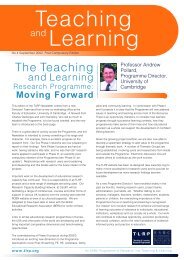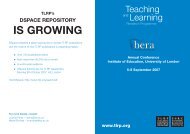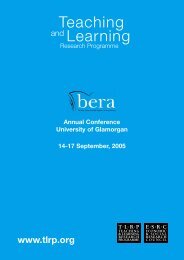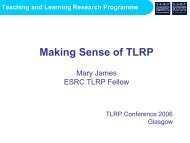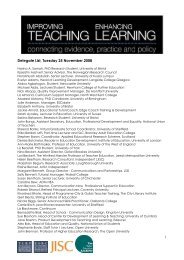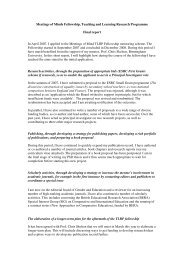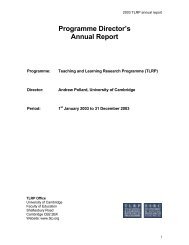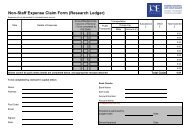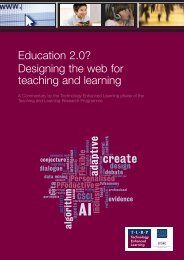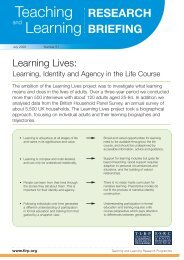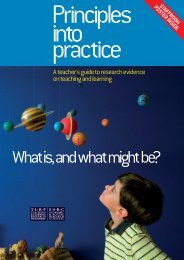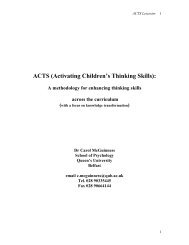Assessment in schools Fit for purpose? - Teaching and Learning ...
Assessment in schools Fit for purpose? - Teaching and Learning ...
Assessment in schools Fit for purpose? - Teaching and Learning ...
Create successful ePaper yourself
Turn your PDF publications into a flip-book with our unique Google optimized e-Paper software.
<strong>Assessment</strong> <strong>in</strong> <strong>schools</strong>. <strong>Fit</strong> <strong>for</strong> <strong>purpose</strong>?<br />
The difficulties many teachers <strong>in</strong> Engl<strong>and</strong> have conduct<strong>in</strong>g effective <strong>in</strong>-class assessment have been extensively<br />
documented by Ofsted. In 2008, it reported: “Too many teachers still fail to see the connection between<br />
accurate <strong>and</strong> regular assessment <strong>and</strong> good teach<strong>in</strong>g which leads to learn<strong>in</strong>g” 12 .<br />
The government <strong>in</strong> Engl<strong>and</strong> is attempt<strong>in</strong>g to tackle this problem by <strong>in</strong>troduc<strong>in</strong>g a £150 million three-year strategy<br />
to promote what it bills as <strong>Assessment</strong> <strong>for</strong> Learn<strong>in</strong>g. Will it work? Analysis of some of the challenges which the<br />
<strong>in</strong>troduction of authentic assessment <strong>for</strong> learn<strong>in</strong>g has faced suggests a cautious response to that question.<br />
Evidence from the TLRP Learn<strong>in</strong>g How to Learn Project has shown that many teachers are committed to the<br />
ideals beh<strong>in</strong>d assessment <strong>for</strong> learn<strong>in</strong>g. For example, of those surveyed, 95 per cent said they believed it was<br />
important or crucial that their pupils were helped to th<strong>in</strong>k about how they learn best; 93 per cent said so <strong>in</strong><br />
connection to them help<strong>in</strong>g pupils to assess their own learn<strong>in</strong>g; <strong>and</strong> 83 per cent said so <strong>in</strong> relation to pupils<br />
be<strong>in</strong>g helped to plan the next steps <strong>in</strong> their learn<strong>in</strong>g.<br />
However, <strong>in</strong> general many fewer teachers reported actually adopt<strong>in</strong>g these techniques <strong>in</strong> practice. Only 63 per<br />
cent reported often or mostly help<strong>in</strong>g pupils to th<strong>in</strong>k about how they learn best; only 69 per cent said so <strong>in</strong><br />
connection with help<strong>in</strong>g pupils to assess their own learn<strong>in</strong>g; <strong>and</strong> only 46 per cent said so <strong>in</strong> relation to help<strong>in</strong>g<br />
them plan their next steps. “It is clear...that teachers’ classroom assessment practices contravene their values,”<br />
said the study.<br />
The Learn<strong>in</strong>g How to Learn project, along with other research, suggests at least five reasons.<br />
First, teachers’ ideals of help<strong>in</strong>g pupils to become more autonomous learners, who are able to reflect on<br />
the development of their underst<strong>and</strong><strong>in</strong>g, often run up aga<strong>in</strong>st the reality of the need to raise their pupils’<br />
per<strong>for</strong>mance on the next summative test. The <strong>purpose</strong> of us<strong>in</strong>g assessment <strong>in</strong>-class to improve underst<strong>and</strong><strong>in</strong>g<br />
often conflicts with its use as a monitor<strong>in</strong>g device by others. The Learn<strong>in</strong>g How to Learn project identified three<br />
dist<strong>in</strong>ct factors <strong>in</strong> classroom assessment practice: “mak<strong>in</strong>g learn<strong>in</strong>g explicit”; “promot<strong>in</strong>g learn<strong>in</strong>g autonomy”;<br />
<strong>and</strong> “per<strong>for</strong>mance orientation”. The first two were seen as <strong>in</strong>tr<strong>in</strong>sic to assessment <strong>for</strong> learn<strong>in</strong>g; the third was not.<br />
While all were seen to be important by teachers, the research found that they tended to prioritise “per<strong>for</strong>mance”<br />
more than they believed was appropriate, while they gave the first two factors less emphasis than they would<br />
have liked.<br />
Some of the difficulty arises from a lack of underst<strong>and</strong><strong>in</strong>g of the difference between “per<strong>for</strong>mance” <strong>and</strong><br />
“learn<strong>in</strong>g”. The em<strong>in</strong>ent psychologist, Carol Dweck, dist<strong>in</strong>guishes two co-exist<strong>in</strong>g orientations. A per<strong>for</strong>mance<br />
orientation is about “look<strong>in</strong>g smart” <strong>and</strong> avoid<strong>in</strong>g look<strong>in</strong>g dumb; a learn<strong>in</strong>g orientation is about “gett<strong>in</strong>g smarter”<br />
by learn<strong>in</strong>g new skills, master<strong>in</strong>g new tasks, or underst<strong>and</strong><strong>in</strong>g new th<strong>in</strong>gs. An over emphasis on per<strong>for</strong>mance<br />
goals can drive out learn<strong>in</strong>g. In Engl<strong>and</strong>, this has implications <strong>for</strong> the over-emphasis on tick<strong>in</strong>g off levels <strong>and</strong> sublevels<br />
<strong>in</strong> national curriculum atta<strong>in</strong>ment targets. Levels that are supposed to be <strong>in</strong>dicators of learn<strong>in</strong>g become the<br />
goals themselves <strong>and</strong> can be “clocked up” without any guarantee that the underly<strong>in</strong>g learn<strong>in</strong>g has occurred.<br />
Second, there are pressures on teachers’ time, <strong>in</strong>clud<strong>in</strong>g the need to cover all aspects of the national<br />
curriculum. This means there may be limited opportunities <strong>for</strong> pupils to develop the self-reflective capacities that<br />
are central to assessment <strong>for</strong> learn<strong>in</strong>g. As one teacher told the Learn<strong>in</strong>g How to Learn project researchers: “In<br />
the ma<strong>in</strong>, we’re try<strong>in</strong>g to put too much <strong>in</strong>to the curriculum <strong>and</strong> not allow<strong>in</strong>g the children to explore <strong>and</strong> enjoy<br />
fewer th<strong>in</strong>gs <strong>and</strong> make stronger l<strong>in</strong>ks...we’re gallop<strong>in</strong>g through”.<br />
12 Ofsted (2008) Memor<strong>and</strong>um to House of Commons Children, Schools <strong>and</strong> Families <strong>in</strong>quiry <strong>in</strong>to<br />
<strong>Assessment</strong> <strong>and</strong> Test<strong>in</strong>g, 2007/08.<br />
21



